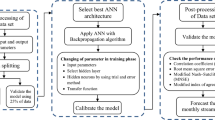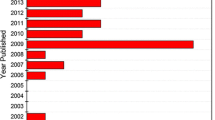Abstract
Stream flows are highly non-linear and complex in nature in any hydrological system. Lack of data availability for modeling requires use of specific model with high accuracy and efficiency which are capable in generating accurate hydrological response. In this paper, capability of artificial neural network model was investigated by utilizing eight years’ (2009–2016) of daily river flow and rainfall data for the Sot river catchment in Uttar Pradesh state of India. For investigating the effect of variables on river flow prediction, four ANN models were calibrated and validated for the period of 2009 to 2014 and 2015 to 2016, respectively, using different combinations of input parameters. Accuracy of developed ANN models was assessed by four performance indicators, namely correlation coefficient, root-mean-square error, modified Nash–Sutcliffe efficiency and Modified Index of Agreement. The results of the study indicate that performance of ANN model improves drastically after including the lag 1 river flow as an input parameter. It is concluded that the ANN model has the ability to solve highly complex non-linear river flow prediction and can be further used for the generation of synthetic river flow data of the Sot river catchment.












Similar content being viewed by others
References
Anmala J, Zhang B, Govindaraju RS (2000) Comparison of ANNs and empirical approaches for predicting watershed runoff. J Water Resour Plan Manag 126(3):156–166. https://doi.org/10.1061/(ASCE)0733-9496(2000)126:3(156)
ASCE (2000) Artificial neural networks in hydrology II: hydrologic applications by the ASCE Task committee on application of artificial neural networks in hydrology. J Hydrol Eng 5(2):124–137. https://doi.org/10.1061/(ASCE)1084-0699(2000)5:2(115)
ASCE (2000) Artificial neural networks in hydrology. I: preliminary concepts by the ASCE task committee on application of artificial neural networks in hydrology. J Hydrol Eng 5(2):115–123. https://doi.org/10.1061/(ASCE)1084-0699(2000)5:2(124)
Bourdin DR, Fleming SW, Stull RB (2012) Streamflow modelling: a primer on applications approaches and challenges. Atmos Ocean 50(4):507. https://doi.org/10.1080/07055900.2012.734276
Butts MB, Payne JT, Kristensen M, Madsen H (2004) An evaluation of the impact of model structure on hydrological modelling uncertainty for stream flow simulation. J Hydrol 298(1–4):242–266. https://doi.org/10.1016/j.jhydrol.2004.03.042
Dadson SJ, Hirpa F, Thomson P, Konar M (2019) Monitoring and modelling hydrological processes. In: Dadson Simon J, Garrick Dustin E, Penning-Rowsell Edmund C, Hall Jim W, Hope Rob, Hughes Jocelyne (eds) Water Science, Policy, and Management: A Global Challenge. Wiely, pp 117–137. https://doi.org/10.1002/9781119520627.ch7
Devia GK, Ganasri BP, Dwarakish GS (2015) A review on hydrological models. Aquatic Procedia 4:1001–1007. https://doi.org/10.1016/j.aqpro.2015.02.126
Fashae OA, Olusola AO, Ndubuisi I, Udomboso CG (2018) Comparing ANN and ARIMA model in predicting the discharge of River Opeki from 2010 to 2020. River Res Appl 35(2):169–177. https://doi.org/10.1002/rra.3391
Hsu KL, Gupta HV, Sorooshian S (1995) Artificial neural network modelling of the rainfall-runoff process. Water Resour Res 31(10):2517–2530. https://doi.org/10.1029/95WR01955
Huang W, Xu B, Chan-Hilton A (2004) Forecasting flows in Apalachicola River using neural networks. Hydrol Process 18(13):2545–2564. https://doi.org/10.1002/hyp.1492
Kasiviswanathan KS, Sudheer KP (2013) Quantification of the predictive uncertainty of artificial neural network based river flow forecast models. Stoch Env Res Risk Assess 27(1):137–146. https://doi.org/10.1007/s00477-012-0600-2
Kisi O, Kerem Cigizoglu H (2007) Comparison of different ANN techniques in river flow prediction. Civ Eng Environ Syst 24(3):211–231. https://doi.org/10.1080/10286600600888565
Legates DR, McCabe GJ Jr (1999) Evaluating the use of “goodness-of-fit” measures in hydrologic and hydroclimatic model validation. Water Resour Res 35:233–241. https://doi.org/10.1029/1998WR900018
Liu Y, Ye L, Qin H, Hong X, Ye J, Yin X (2018) Monthly streamflow forecasting based on hidden Markov model and Gaussian Mixture Regression. J Hydrol 561:146–159. https://doi.org/10.1016/j.jhydrol.2018.03.057
Moradkhani H, Hsu KL, Gupta HV, Sorooshian S (2004) Improved streamflow forecasting using self-organizing radial basis function artificial neural networks. J Hydrol 295(1–4):246–262. https://doi.org/10.1016/j.jhydrol.2004.03.027
Rumelhart DE, Hinton GE, Williams RJ (1986) Learning internal representation by backpropagating errors. Nature 323:533–536
Shamim MA, Hassan M, Ahmad S, Zeeshan M (2015) A comparison of artificial neural networks (ANN) and local linear regression (LLR) techniques for predicting monthly reservoir levels. KSCE J Civ Eng 20(2):971–977. https://doi.org/10.2166/hydro.2010.027
Shamseldin AY (2010) Artificial neural network model for river flow forecasting in a developing country. J Hydroinf 12(1):22–35. https://doi.org/10.1007/s12205-015-0298-z
Wang WC, Chau KW, Cheng CT, Qiu L (2009) A comparison of performance of several artificial intelligence methods for forecasting monthly discharge time series. J Hydrol 374(3–4):294–306. https://doi.org/10.1016/j.jhydrol.2009.06.019
Willmott CJ, Ackleson SG, Davis RE, Feddema JJ, Klink KM, Legates DR, O’Donnell J, Rowe CM (1985) Statistics for the evaluation and comparison of models. J Geophys Res: Ocean 90:8995–9005. https://doi.org/10.1029/JC090iC05p08995
Yaseen ZM, Ebtehaj I, Bonakdari H, Deo RC, Mehr AD, Mohtar WHMW, Diop L, El-Shafie A, Singh VP (2017) Novel approach for streamflow forecasting using a hybrid ANFIS-FFA model. J Hydrol 554:263–276. https://doi.org/10.1016/j.jhydrol.2017.09.007
Acknowledgements
This work was fully supported by National Hydrology Project (NHP) funded by World Bank and Ministry of Jal Shakti, Government of India. The authors are grateful to the Director, National Institute of Hydrology (NIH), Roorkee (India), for providing necessary support to conduct this study.
Funding
This work is carried out under the National Hydrology Project (NHP) funded by Ministry of Jal Shakti (GoI) through World Bank.
Author information
Authors and Affiliations
Corresponding author
Ethics declarations
Conflict of interest
The authors declare that they have no conflict of interest.
Ethical Approval
This article does not contain any studies with human participants or animals performed by any of the authors.
Additional information
Publisher's Note
Springer Nature remains neutral with regard to jurisdictional claims in published maps and institutional affiliations.
Rights and permissions
About this article
Cite this article
Sharma, P., Singh, S. & Sharma, S.D. Artificial Neural Network Approach for Hydrologic River Flow Time Series Forecasting. Agric Res 11, 465–476 (2022). https://doi.org/10.1007/s40003-021-00585-5
Received:
Accepted:
Published:
Issue Date:
DOI: https://doi.org/10.1007/s40003-021-00585-5




